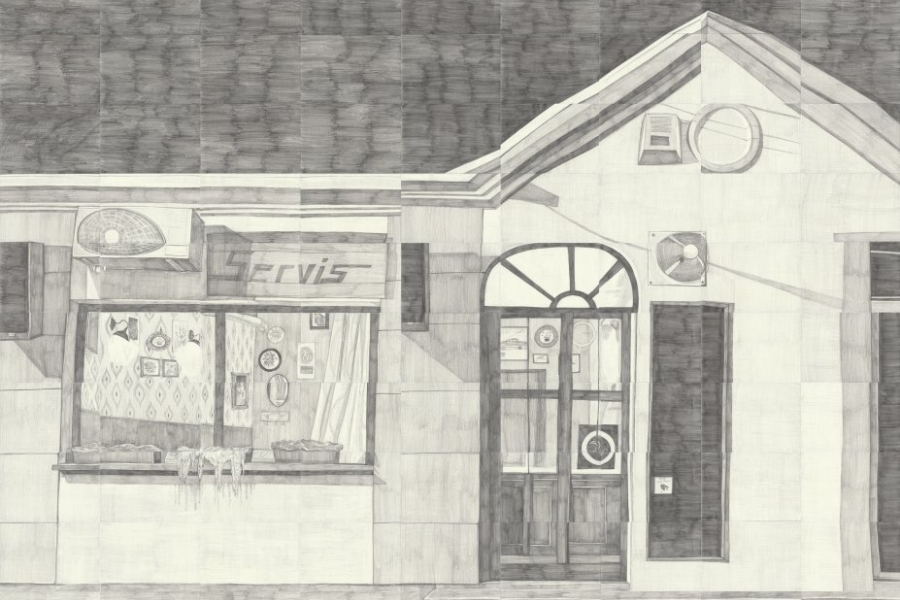The General in His Labyrinth

“Damn it”, he sighed. “How will I ever get out of this labyrinth!”
Wandering into Ksenija’s works – within drawings of space, or the movements through and around space – feels like stepping into a vivid dreamscape that suddenly comes to life. There is no pause to consider its potential meaning, before something abruptly pulls us in. Our encounters with the paper – and heaps of it, sprawling across the walls – turn the dream lucid. Suddenly awoken into epiphany, the viewer turns their gaze to different micro-formats, choosing which one to peer into, which memory to recognise as their own. Then, as if reflecting the drawn spaces, the viewer’s gaze turns inward, in introspection, flickering through the endless chambers of their own materiality and thus transience, suddenly realising: there is no one here, no one at all, yet everything is brimming with presence. Entering Ksenija’s works thus feels like déjà vu – it’s all somehow familiar, we’ve been here before: in a car, a tunnel, an overpass, a café, at the bar, with a glass, beneath lamps, down streets and hallways, deep within ourselves. It all feels the same, yet slightly different – and precisely through that difference is where the beauty unfolds, flooding us in the process.
The artist’s technique seems deceptively naive – softly tinted, ochre paper and graphite pencil – like a pre-schooler’s toolkit, the contents of any pencil case, of childhood itself. And yet, the pencil’s path draws a way through the labyrinths in which Ksenija’s distinct – and already recognisable – visual language roams, seeking its most fitting form. Her repetitive pencil strokes aren’t random scribbles (at least, not yet), they don’t lose their rhythm – instead, the repetition mimics a constant resurfacing of memory, as familiar, but slightly altered images. From afar, Ksenija’s works cover entire walls with what look like complete, realistic reproductions, creating the illusion of something static, an indisputable memory. But a closer look reveals fragments and inconsistencies, which indicate the fragility and ephemerality of both the works and their viewers. Just like Márquez, the artist merges realism and magic through the hastily joined papers, miniscule pencil strokes, and the occasional overlaps and gaps, which appear only when the artist assembles the parts into a quasi-whole on the wall, the blank page of our expectations. It is within these graphite layers that words suddenly appear – names, like your name or mine – toponyms, graffiti, inside jokes, local slang and situational humour, traces of everyday communication hidden by shadows and shadings. And it’s right there, within these deliberate imprecisions, that everything that Ksenija identifies with – like Márquez, Servis, Milanovac, her friends – finds its authentic expression. One that cannot be encompassed through mere exhibition text or a single work. It is there that pencil and paper swing-open the doors for a giraffe, a bar stool, for uzmi račun, for CCTV, creating a warm and comforting space, familiar to all, though deeply intimate and local.
In this way, Ksenija disintegrates all that seems stable and monumental when viewed from a distance. Both the technique and themes of her works open up space beyond the habitual, exposing the vulnerabilities of long and detailed labour, breaking away from the linearity of perception, time and duration. Like Klee’s Angelus Novus – which Benjamin describes with its gaze fixed on the past, being pulled from its back into the future by the storm of progress – Ksenija’s imaginative worlds urge us to pull the emergency brake, snapping us out of the capitalist frenzy, of salon-esque, project-commissioned art, back to our more intimate spaces of making and unmaking. The labyrinth of her subjectivity thus isn’t a path of greats – it’s a space that’s both yours and mine, it’s our favourite place.
Emilija Vučićević
Sources:
Benjamin, Walter. Theses on the Philosophy of History. Translated by Harry Zohn, in Illuminations, edited by Hannah Arendt, Schocken Books, 1968, pp. 253–264
García Márquez, Gabriel. The General in His Labyrinth. Translated by Edith Grossman, Alfred A. Knopf, 1990
Photos by: N. Ivanović
